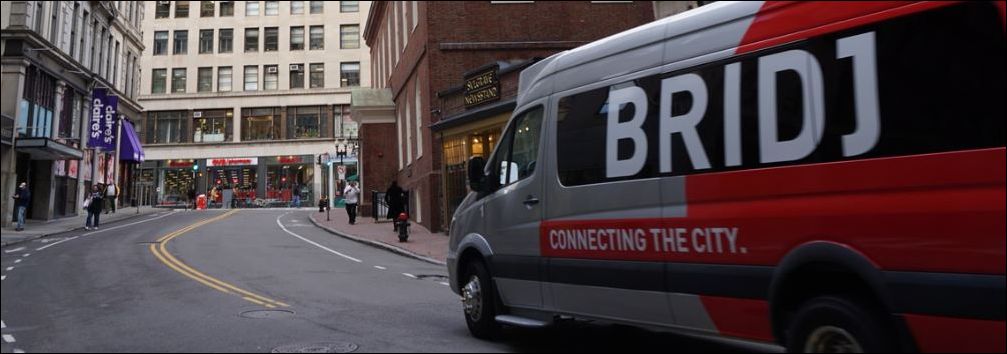by James A. Bacon
Later this month, 13-person vans emblazoned with the Bridj brand will begin ferrying Virginians, Marylanders and D.C. residents to destinations throughout the Washington metropolitan area, filling an under-served niche in the transportation marketplace. For $3 to $5, little more than the cost of a bus ticket, riders will be able to ride directly from Point A to Point B as long as enough of them are willing to share the ride. The trips will be 20% slower on average than if passengers drove their own cars, but the cost will be less than operating and parking a car. Trips will be marginally more expensive than a bus ticket, but they will be 30% to 40% faster.
“We aim to fill the doughnut hole between car and bus,” Bridj CEO Matt George told me in an interview yesterday. “We don’t have routes or schedules. The routing is dynamic. People tell us where they need to go. We direct them to a pop-up mass transit stop. The vehicle expresses them to a drop-off point within a five- to ten-minute walk of their destination.”
Bridj vehicles carry 13 passengers, have comfortable seats and come equipped with Wi-Fi and USB power. That makes passengers’ time on board more productive, George said, whether they want to check their work email or play Flappy Bird.
The Boston-based Bridj doesn’t see itself as a transit company, however. It’s a technology company. Its core competency is matching supply with demand: identifying clusters of people who want to travel between the same two locations at roughly the same time. The company outsources the actual driving to local partners who are licensed as operators to provide the vehicle and driver.
“We’re looking at billions of data points a day to understand where the city is moving,” George said. What are those data points? He won’t say — it’s proprietary. However, the company website refers to “dozens” of data streams, and it invites prospective riders to submit home addresses and work addresses online. The 25-person company has two research teams dissecting the data. One is led by an MIT PhD, the other by a Columbia University PhD.
Bridj is enlarging the market for mass transit. George said that, based on its Boston experience, about 20% to 30% of riders are new to mass transit. Bridj will provide transportation connections to parts of the Washington metro area that don’t have bus service. In Washington, like Boston, a third of city residents don’t own cars. Similarly, 40% of the jobs in each metropolitan area are inaccessible by transit in 90 minutes or less.
However, the other 70% to 80% are transit riders — Bridj’s gain is the local bus company’s loss. Municipal bus companies tend to be financially precarious enterprises. Would they not see Bridj as the same kind of threat to their operations as, say, Uber represented to taxicab companies? Will Bridj stimulate the same kind of political backlash that Uber did?
I asked George that question, and he gave a mixed message. On the one hand, he affirmed strongly that Bridj is far more efficient — up to nine times more — on a cost-per-passenger basis than conventional transit companies. The standard model for municipal transit companies is to run on scheduled routes at scheduled times. The buses rarely travel full; indeed many travel almost empty. Moreover, city buses typically cost ten times more than Bridj vans. The average cost per passenger trip for municipal buses in Boston is in the realm of $13 to $15 per passenger trip, said George, adding the caveat that he hadn’t checked the figures recently and could be off somewhat. By contrast, Bridj buses run full. The company charges $3 to $5 per ticket, depending upon whether it’s on-peak or off-peak traffic — and it makes a profit.
On the other hand, George downplayed the idea that Bridj represents a threat to city bus companies. Bridj shares its data with city bus companies. (He didn’t say to what purpose, but I would conjecture to help bus companies optimize their own routes.) “They see the ability to work with Bridj in the future,” he said. “We’re open to discussion.”
Bridj announced its move into the Washington market in late February. “We’re in the final stages of vendor selection,” George said. “We’ll be on the road in the next couple of weeks.”
Bacon’s bottom line: Just as Uber turned the economics of the taxicab business on its head, Bridj is transforming the transit bus business. It’s expanding the market for transit, but it’s also siphoning off existing mass transit riders. I can’t help but think that at some point bus companies will start complaining that Bridj is “skimming the cream,” weakening them financially and endangering their ability to maintain service to the poor. Insofar as the transit bus business is bigger than the taxicab industry, I would expect the political pushback to be commensurately bigger than the opposition that Uber faced.
But there is one big difference. Uber was unapologetically confrontational. Bridj appears to be taking a much lower-key approach to entering the Washington market. George is shrewd to consult with local authorities in advance and position Bridj as a “partner.” Insofar as George can provide valuable data that enables bus companies to improve their operations, municipal transit companies actually may welcome Bridj into the market.
Regardless of how the vested interests might feel about Bridj, the company brings a welcome transportation alternative to the Washington regions. Any innovation that expands the marketplace for shared ridership and spurs sluggish local transit companies to up their game is a good thing.



